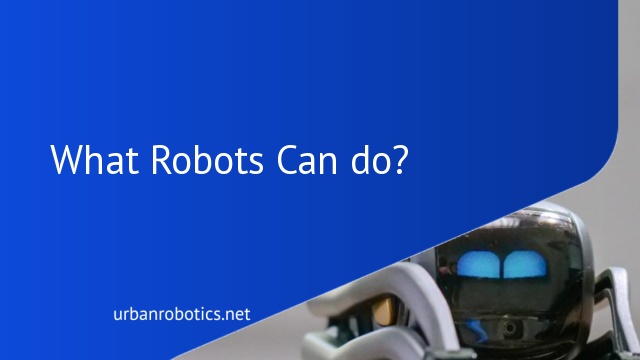Robots, once the fascinating stuff of futuristic fantasy, have really come into their own and are expected to co-exist with human society. That day is not a long way off when this most incredible type of disruptive innovation will touch every aspect of human life and transform the way we live at a breathtaking pace.
The fast acceleration of the world towards the era of new generation robotics has made us feel like our robot-filled future is speedily becoming our robot-filled present – thanks to the recent robotic revolution.
But what robots can do, and are they an unmixed blessing with no adverse effects on human life? To know more about the sophisticated capabilities of today’s advanced robots, read on.
What is a Robot?
A robot is an embodied device with an integrated control system, inter-connected motor drives, and sensors. An advanced robot sometimes incorporates some degree of AI and complex locomotion that allow them to move, interact with the surrounding environment and objects and react accordingly to perform specific tasks.
Types of Robots
Robots come in various shapes and sizes, can be autonomous or semi-autonomous, and have some sort of flexibility.
Robots can be of different types:
- A guided or off-line programmed robot, for instance, a mechanical arm on an automotive assembly line, can execute well-defined activities in well-regulated environments.
- A semi-autonomous robot, for instance, a tele-operated machine, has a definite degree of self-governance and requires human control to operate appropriately. Examples can be drones, surgery assisting robots, etc.
- Autonomous robots have a higher degree of self-independence than semi-autonomous ones thus can function without recourse to human command over a specific time. For instance, Roomba, the vacuum cleaner, can navigate a room floor independently, cope with the objects using its built-in sensors and clean the area like a pro. It means that all robots have to be at least semi-autonomous.
- Another stupendous innovation of robotics is humanoid robots – machines that can mimic the human body, behaviour, facial expressions, and even emotions. Perhaps the most famous humanoid is Sophia, a 5-years old gynoid that is now officially a citizen of Saudi Arabia.
How Do Robots Enter the Workplace?
In the World Robotics Report 2020, IFR (The International Federation of Robotics) says that there has been a sharp rise in demand for robotisation in the worksite resulting in a shoot up in sales of industrial robots over the last few years.
The report indicates that these sophisticated automated machines are entering the workplace and efficiently interacting and teaming with humans. The result is, the robotics industry is booming, and robotics engineering is rapidly becoming a lucrative study and career option with immense possibilities.
The motives for engaging robots in industrial operations are many – cost efficiency, better performance and precision, bolstered productivity, better and secure workplace and the list goes on.
What Robots Can Do?
As we have already stated, robots can be a tremendous help that executes human commands or gather information from the surroundings to react independently and accomplish tasks.
Here are a few among many significant areas where robotics is making cogent and strong strides:
Repetitive Tasks
Repetitive tasks, for instance, consolidating a massive volume of data from various sources or tightening bolts and nuts daily, can be super-boring and wane productivity, right? Plus, monotonous activities that demand uninterrupted attention and allow no free time only kill employees’ creativity – research says.
Thankfully, robots are already there to relieve their human counterparts from such drudgeries and guess what? Robots do so without nodding or getting exhausted, nor slowing down with consistent quality! An ideal example can be robots Amazon employs in their shipping warehouses that enable employees to save around 20-miles of walking every day.
Extreme sensing
The sensors, both internal and external, act as a window for a robot to the environment, enabling it to collect, measure and comprehend data about the surrounding properties of the environment and objects like temperature, pressure, luminance, etc.
Various advanced and high-precision sensors, including photosensors, sound sensors, tactile and proximity sensors, etc., have made plug-and-play robotic ecosystems rise exponentially. These highly-sensitive built-in sensors transmit signals to the control system from the surroundings and help the machine execute commands and operate just perfectly even in unforeseen and potentially dangerous environments. For instance, while an AI-powered intelligent robot with a custom-designed embedded tactile and proximity sensor can automatically detect surface cracks, one with a built-in high-level vision sensor can see through any rigid element, like walls, to identify holes.
Strength and speed
Today the autonomously powered advanced industrial robots act as ‘force multipliers’ to transform and level up manufacturing and production operations. These highly dexterous robots can do any labour-intensive tasks promptly with precision – thanks to the dramatic advancements made in robotics in the last few decades.
From lifting heavy objects and handling a large volume of land for harvesting to detonating IED (improvised explosive devices) remotely and investigating still-radioactive environments hazardous to human health, robots can accomplish almost all laborious jobs without ever calling in sick!
Objective Detection
Object detection and recognition are two of the basic skills assistive robots must possess to adapt to human environments and help them do tasks mainly in the machine vision industries where accurate object detection is essential for better task inspection, registration and manipulation. But the problem is the robot has to interact with things of various extents, measures, and degrees of mobility.
Though still a challenging job, roboticists are trying to incorporate real-time visual data processing, and computer vision techniques in autonomous assistive robotic machines and precise object recognition and detection algorithms are the prerequisite to these high-level capabilities. Thanks to modern deep learning, a subfield of machine learning, and various object detection approaches like Coarse-to-Fine and Boosted Classifiers, Bag of Word method, Deformable Part-Based Model, and more for enabling AI-based robots and computer vision systems to precisely recognise objects. For instance, self-navigating vision machines use a high-level multi-camera setup capable of capturing an image of an object from multiple angles and picture generation built-in sensors (as Lidar and Radar) for accurate object detection.
Will Robots Replace Human Workers?
Will automated machines ever perform as a substitute for humans in every workplace and position? Though robotics is an interdisciplinary study area with tremendous opportunity and robots have the power to shape the future, they aren’t being designed to substitute humans in every sector in a workplace or snatch jobs from them. Instead, they are meant to help their human counterparts, free them from doing dangerous and repetitive tasks and improve production efficiency by operating optimally. So, for now, and the foreseen future, the straightforward answer to this question is still NO. But evaluating the long-term trend around the uptake of AI and robotics, economists and researchers predicted that by 2030, automation can take over approximately 20 million production and manufacturing jobs worldwide.
A study conducted by the business network PwC predicts an AI takeover in up to 30% of jobs by mid-2030.
It means, while the robotic revolution will not take over every job, there might be a sharp rise in robot usages in jobs including telemarketing, sewer management, automated shipping services, etc.





